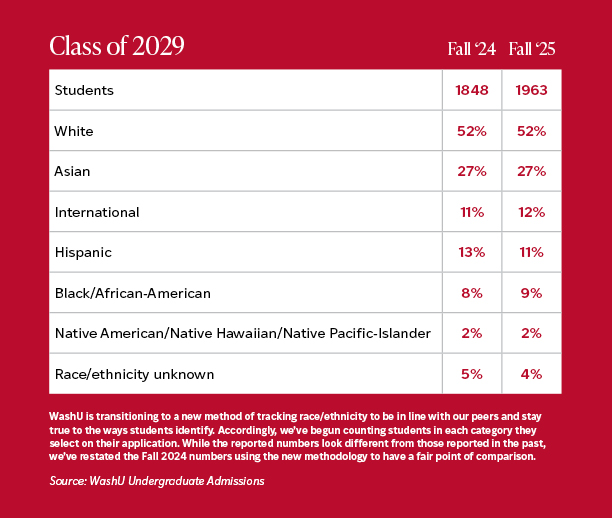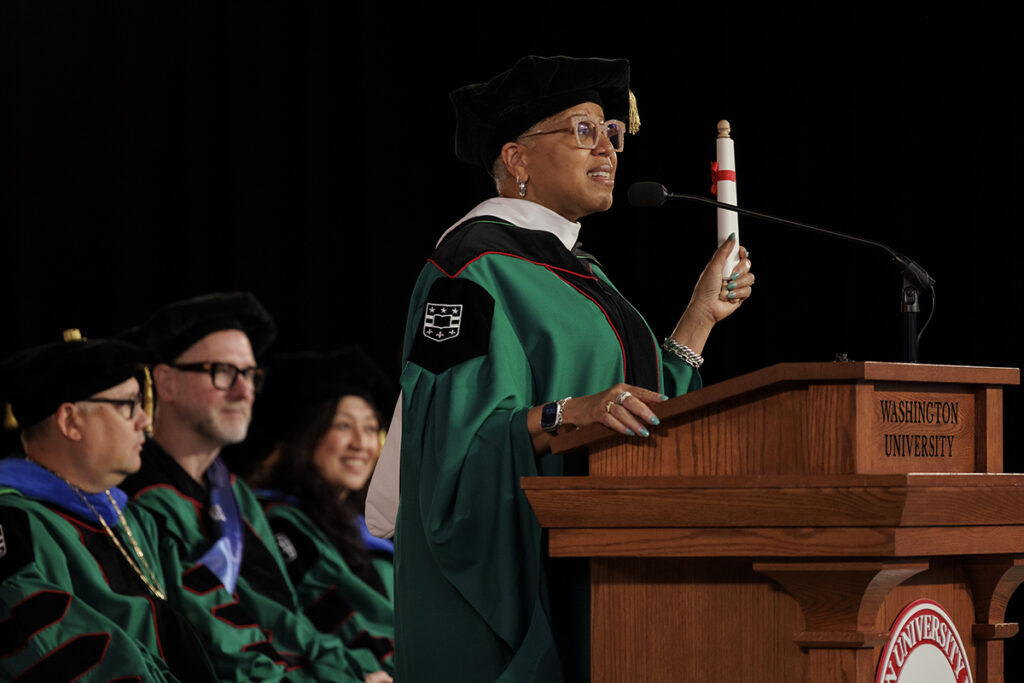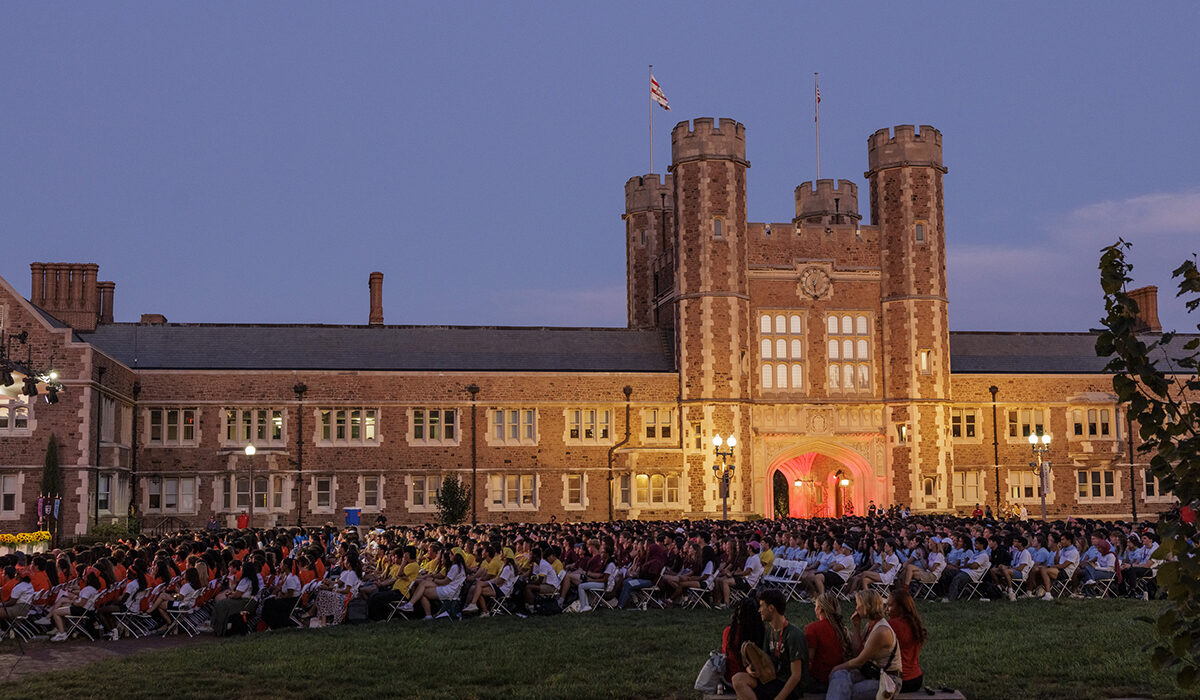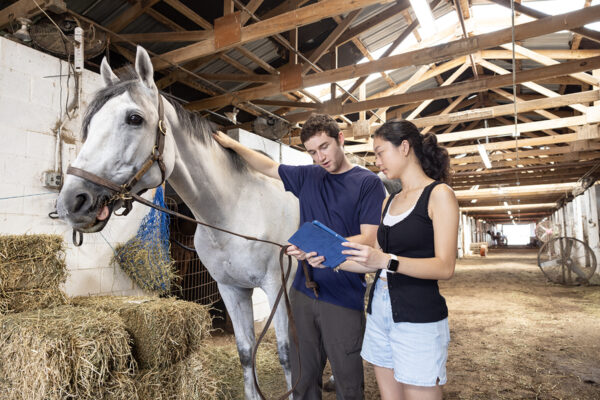Washington University in St. Louis continues to draw talented students from across the nation and around the globe. The Class of 2029 is the second-largest in university history and comprises 1,963 students from 49 states and 29 countries. While American universities continue to navigate federal guidelines that have changed how they recruit and admit students, WashU’s incoming class represents a wide variety of backgrounds and perspectives.
“Fundamentally, WashU believes that when talented students from a variety of experiences, backgrounds, perspectives and academic interests apply, you are able to build a dynamic community,” said Ronné Turner, vice provost for undergraduate enrollment and student financial aid. “The Class of 2029 is all of those things — talented, collaborative and ready to contribute meaningfully to our university community.”
The university admitted about 12% of its 33,283 applicants. The percentage of Pell Grant-eligible students is 23. (Federal Pell Grants support students with significant financial need.) Sixteen percent of students are the first in their families to attend college. About 42% of students are receiving financial aid awards; the average aid package is more than $75,000. Rural students make up 8% of the incoming class, and 5% of the class is eligible for the WashU Pledge, which supports students from Missouri and southern Illinois who come from families earning $75,000 per year or less.
Here, Turner explains why WashU’s international numbers have stayed strong, reflects on the success of WashU college access programs and peeks over the “demographic cliff.”

WashU continues to admit a significant number of first-generation and Pell-eligible students. Still, there was a slight decline this year. What happened?
This was a very complicated admissions cycle. We understood that there was a chance that many of our admitted international students wouldn’t be able to obtain a visa. So, in anticipation of summer melt, we were able to say yes to more students on our wait list. In the end, summer melt was lower than anticipated, which resulted in a larger incoming class. This impacted the overall percentages.
Are you surprised that so many international students applied to WashU given the changing federal guidelines and revocation of student visas?
One of the things that I’ve learned as I’ve been recruiting abroad is that international families still value a U.S. education. These families are still so excited about their kids getting into WashU, and we make it clear that their students are welcome here and that we have a lot of support and services for them.
What is your message to students who place a high value on having a diverse community?
It’s important to us that we recruit and enroll a class that includes students from all backgrounds. This makes our class and our campus community stronger. What I would say to our students who care about the diversity of our class is to continue their participation in the WashU community. Their contributions are making WashU an open and inclusive community for all. There are limitations to what we can do legally in our recruiting practices, but just because there have been some changes to the way we’re able to approach our work, that doesn’t mean our institutional values have changed. We remain fully committed to serving students with a diversity of experiences, backgrounds and viewpoints. This class chose WashU because they believe in that mission. And so the more we get students from a variety of backgrounds and viewpoints in the classroom, and involved in extracurricular life, the more we’re going to be able to attract students who share our institutional values. Additionally, we have made some changes to the way we report our data (see chart) and that has affected how this year’s percentages look.

A lot of critics of higher ed admissions conflate merit with test scores and grades. How do you define merit?
We look at merit through the lens of our WashU values. Merit is more than an overall GPA or a test score because of the variety of educational opportunities and experiences available to students. Some schools have weighted GPAs, some schools don’t. Some schools have a five-point scale, some schools don’t. Some offer advanced courses, AP, and honors, and some don’t. So looking at just a GPA number or a test score doesn’t necessarily tell you anything about how well prepared a student is for a place like WashU. Strong grades and a rigorous curriculum can tell us that a student knows how to study and is engaged in their learning. But what we’re really looking to understand is how well the student has taken advantage of the academic opportunities within their educational environment.
We also are trying to determine whether a student is going to bring something positive to our community. We’re looking to see if they’ve been engaged in their home or school community. We think that’s important because there’s so much to do here on campus, and when you come from a background where you are engaged in something you care about — whatever that may be — and continue to do well with your schoolwork, that’s a good signal that you can be successful. We also look at recommendations very carefully, because we want to understand how that student contributes to their community. At WashU, we’re known for being this collaborative, supportive community, and when recommenders talk about students who are always willing to help a fellow student or were a good team member on a project, that is important.
Speaking of test scores, will WashU remain test-optional?
We have really taken the opportunity to study the impact of the test-optional policy, which was initially driven by COVID and the inability of students to have access to sit for standardized testing. We just graduated the first class that was admitted test-optional. And we are looking closely at the data and anticipate that the university will make a decision about our test-optional policy sometime this year. We will remain test-optional for the Class of 2030.
Ten members of the inaugural cohort of WashU’s Rural Scholars Academy and 10 College Prep Program graduates are part of the Class of 2029. Many of them will attend WashU at no cost through the WashU Pledge. Can you talk about the success of these access programs?
It’s really exciting. One of the biggest issues that impacts first-generation and limited-income students is that they haven’t had the same exposure to what it takes to be successful in the college admissions process and, in particular, the highly selective college admissions process. The Rural Scholars Academy did a great job preparing these talented students for that process. The College Prep Program is a little bit different because its primary goal is to increase the college-going rate of talented first-generation and limited-income students from the St. Louis region. We want to expand their knowledge, their horizons and prepare them for whatever college choice they may make. For some students, that’s going to be a school out of state; for some, it’s community college. We’re excited that for 10 of those graduates, WashU was the best choice.
There is a lot of talk about the ‘demographic cliff’ that colleges are facing due to declining birth rates. Does WashU’s acceptance rate of 12% insulate us from this trend?
Not necessarily. We don’t think that we will be as impacted as some small liberal arts institutions, but everyone is thinking about the demographic cliff. We have regional admissions officers in Atlanta and in Texas, and we’re hoping to add a regional officer in the West because that is where there is growth in the college-going population. We continue to work on increasing the university’s name recognition and brand reputation. There are still people out there who don’t know who we are or think that we are in Seattle or Washington, D.C. Our team is out there working hard to ensure prospective students and their families know the WashU name and story.



